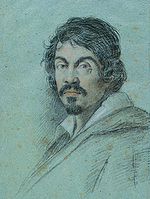- Conversion on the Way to Damascus
-
The Conversion on the Way to Damascus 
Artist Caravaggio Year 1601 Type Oil on canvas Dimensions 230 cm × 175 cm (91 in × 69 in) Location Santa Maria del Popolo, Rome The Conversion on the Way to Damascus (Conversione di San Paolo) is a masterpiece by Caravaggio, painted in 1601 for the Cerasi Chapel of the church of Santa Maria del Popolo, in Rome. Across the chapel is a second Caravaggio painting (1600) depicting the inverted Crucifixion of St. Peter. On the altar, is a luminous and crowded Assumption of the Virgin Mary by Annibale Carracci. The dome frescoes are by one of Carracci's apprentices, under his design. The chapel was painted for Monsignor Tiberio Cerasi, who died in 1601 and had been treasurer general under Clement VIII. The commission for Caravaggio (and perhaps Carracci) was apparently secured by his newly acquired patron, Marchese Vicenzo Guistiniani.
The painting depicts the moment recounted in Chapter 9 of Acts of the Apostles when Saul, soon to be the apostle Paul, fell on the road to Damascus. He heard the Lord say "I am Jesus, whom you persecute, arise and go into the city" (see Conversion of Paul). The Golden Legend, a compilation of medieval interpretations of biblical events, may have framed the event for Caravaggio.
Caravaggio's first version of the Conversion painting is in the collection of Principe Guido Odescalchi. It is a much brighter and more Mannerist canvas, with an angel-sustained Jesus reaching downwards towards a blinded Paul.
Other paintings
Caravaggio, or his patron, would have known the Michelangelo frescoes (1542–45) in the Vatican Cappella Paolina when choosing how to represent this theme. However, the Caravaggio scene is far more stark than the confusing miracle melee of the Mannerist Michelangelo fresco (1542–45).[1] While tighter in scope, Taddeo Zuccari's preparatory drawing (1560) for a fresco appears more like a polo accident than a miracle;[2] the completed painting in San Marcello al Corso (1563) is also a Mannerist contortion. One depiction, likely not have been available to Caravaggio, is the somewhat cartoonish painting by Lucas Cranach. Finally, the prostrate man's state and extended arms recall, but contrast, with the epileptic boy's trance in Raphael's final masterpiece of the Transfiguration found in the Pinacoteca Vaticana.
References
External links
Categories:- Caravaggio paintings
- 1601 paintings
- Paintings with biblical themes
- Paul the Apostle
Wikimedia Foundation. 2010.

